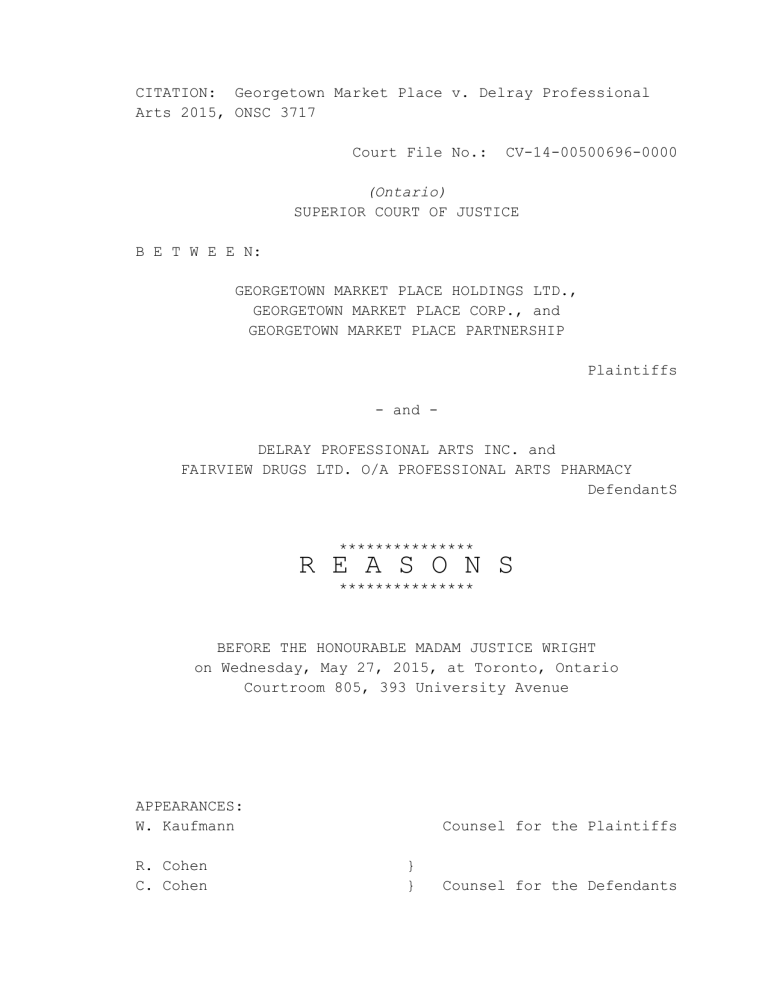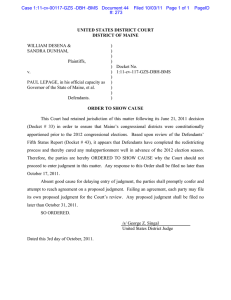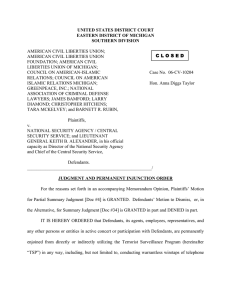CITATION: Georgetown Market Place v. Delray Professional

CITATION: Georgetown Market Place v. Delray Professional
Arts 2015, ONSC 3717
Court File No.: CV-14-00500696-0000
(Ontario)
SUPERIOR COURT OF JUSTICE
B E T W E E N:
GEORGETOWN MARKET PLACE HOLDINGS LTD.,
GEORGETOWN MARKET PLACE CORP., and
GEORGETOWN MARKET PLACE PARTNERSHIP
Plaintiffs
- and -
DELRAY PROFESSIONAL ARTS INC. and
FAIRVIEW DRUGS LTD. O/A PROFESSIONAL ARTS PHARMACY
DefendantS
***************
R E A S O N S
***************
BEFORE THE HONOURABLE MADAM JUSTICE WRIGHT on Wednesday, May 27, 2015, at Toronto, Ontario
Courtroom 805, 393 University Avenue
APPEARANCES:
W. Kaufmann Counsel for the Plaintiffs
R. Cohen }
C. Cohen } Counsel for the Defendants
1
Reasons for Judgment
(Wright J.)
WEDNESDAY, MAY 27, 2015
CITATION: Georgetown Market Place v. Delray Professional
Arts 2015, ONSC 3717
REASONS FOR JUDGMENT
WRIGHT J. (Orally):
Introduction
This is a motion for a summary judgment by the plaintiffs on a royalty agreement that dates back to August 5, 1987. The factual backdrop of this matte0r is somewhat complicated. The chronology of the material events that are essentially agreed upon by both parties is set out in a helpful chart marked as "Tab A" in the defendants' factum.
I accept that chronology of the facts for the purposes of this judgment and I do not intend to repeat them now.
Positions of the Parties
The plaintiffs claim that there has been an equitable assignment of the royalty agreement by 253000 to GMP Partnership. They say that the equitable assignment is valid and binding, and payments under the royalty agreement are due and owing to the GMP partnership.
Ultimately, they are seeking summary judgment and an order that they receive judgment in
May 27, 2015
2
Reasons for Judgment
(Wright J.) the amount of $443,915.34 for unpaid royalties up to July 2014; judgment for royalty payments between July 2014 and the date of this judgment; and a declaration that the defendants continue to pay the royalties to GMP.
The defendants oppose the summary judgment motion. They argue that the plaintiffs have failed to discharge their evidentiary onus to establish that any of them have the proper chain of title to the benefits of the royalty agreement. Moreover, they argue that there is a genuine issue as to whether the plaintiffs are in breach of their restrictive covenant which they say would legally disentitle them to the benefits of the royalty agreement.
The Law
The jurisdiction of this court to dispose of a claim on a summary motion is set out at
Rule 20 of the Rules of Civil Procedure .
In Hryniak , 2014 SCC 7, the Supreme Court of
Canada very recently reviewed the so-called
"full appreciation test for summary judgment" set out by the Ontario Court of Appeal in
Combined Air Mechanical Services Incorporated v. Flesch , 2011 ONCA 764, and considered when summary judgment can be granted on the basis that there is no genuine issue requiring a
May 27, 2015
3
Reasons for Judgment
(Wright J.) trial as per Rule 20.4(2)(a).
The court also considered when it is against the interests of justice for the new fact-finding powers in Rule 20.04.2.1 to be used on a summary judgment motion.
The threshold consideration is to determine when the summary judgment may be granted.
The Supreme Court in Hryniak noted that summary judgment must be granted when there is no genuine issue requiring a trial.
The court in Hryniak stated that the fundamental question to be answered is whether a summary judgment motion will provide a fair process and just adjudication.
The court went on to say that the "standard for fairness is not whether the procedure is as exhaustive as a trial, but whether it gives the judge confidence that she can find the necessary facts and apply the relevant legal principles so as to resolve the dispute."
The court suggested a two-step process in determining a summary judgment motion.
The first step is for the court to "determine if there is a genuine issue requiring trial" based only on the evidence before her, without using the new fact-finding powers.
May 27, 2015
4
Reasons for Judgment
(Wright J.)
There will be no genuine issue requiring a trial if the summary judgment process provides her with the evidence required to fairly and justly adjudicate the dispute and is a timely, affordable, and proportionate procedure under Rule 20.04(2)(a).
If the court determines there is a genuine issue requiring a trial, then the second step is to assess whether a trial can be avoided by using the new powers under Rule 20.04, subrules (2.1) and (2.2).
The court must determine whether the evidence before it, including any evidence that may be obtained through additional powers is sufficient to make the findings needed to arrive at a final determination of the issues. If yes, then the judgment can be made on the summary motion.
If no, then a trial is required.
Analysis
In this case, I find that the plaintiffs have not met their onus and that there are genuine issues requiring a trial, and here is why.
In my view, there are two significant issues that attach to this case that cannot be resolved by summary judgment.
May 27, 2015
5
Reasons for Judgment
(Wright J.)
This first of course is the issue relating to the assignment of the royalty payments. The test for establishing whether an assignment will be valid is set out in the plaintiffs' factum at paragraph 18 and the defendants' factum at paragraphs 52 through 54. I rely upon them, and do not intend to repeat them now.
In this case, it is conceded that there is and was no legal assignment of the royalty agreement when 253000 was dissolved. Where no assignment at law exists, the evidentiary burden lies on the plaintiff to prove that there was an intention to assign absolutely, such that an equitable assignment can be said to exist.
In an attempt to meet their onus, the plaintiffs' rely on a paper trail which includes the documents illustrating the transferring of corporations and the royalty payments that were made for 20 years without being questioned. I, however, accept the defendants' position that, even within that paper trail, there are irregularities and inconsistencies that are cause for concern.
More important is my assessment of the evidence of the witnesses.
In this case, the plaintiff relies on the
May 27, 2015
6
Reasons for Judgment
(Wright J.) evidence of four individuals to help prove their case -- Sigmund Levy, Eric Levy, Cliff
Levy, and Gregg Fera. All four provided affidavits and all four were cross-examined.
Those affidavits and transcripts have been thoroughly reviewed by me.
I am mindful that in Fraser v. Imperial Bank of Canada , the Supreme Court of considered an equity assignment and stated:
"No form of words is necessary to create an assignment. It is always a question of fact and of the intention of the parties to be gathered from what they said and did and from all the surrounding circumstances."
In my view, any resolution of this matter will, in large measure, turn on the findings of credibility of these witnesses. They are the meat and potatoes of the plaintiffs' case. They should be able to provide a complete understanding of the material documents and distill with clarity the absolute intention of the parties in the assignment of the royalty agreement.
I find they have failed to do so.
The defendants have, in their factum in paragraphs 50 through 70 and in their brief
May 27, 2015
7
Reasons for Judgment
(Wright J.) of transcripts of inconsistencies, accurately set out in detail a myriad of inconsistencies that surfaced in the cross-examinations and attach to each of these witnesses. I accept and adopt those inconsistencies as set out by the defendants in their materials in its entirety.
As a result, I find that these consistencies significantly impinge on the credibility and/or reliability of the aforementioned witnesses. The difficult task of making findings of credibility and reliability in the context of a summary judgment motion has been the topic of much judicial commentary.
Of special note is the judgment of Justice
Lauwers in Baywood Homes Partnership v.
Haditaghi where he said:
"What happened here illustrates one of the problems that can arise with a stage summary judgment process in an action where credibility is important.
Evidence by affidavit prepared by a party's legal counsel, which may include voluminous exhibits, can obscure the affiant's authentic voice. This makes the motion judge's task of assessing credibility and reliability especially difficult in a summary judgment and mini trial context. Great care must be taken by the motion judge to ensure that the
May 27, 2015
8
Reasons for Judgment
(Wright J.) de-contextualized affidavit and transcript evidence does not become the means by which substantive fairness enters in a way that would not likely occur in a full trial where the trial judge sees and hears it all."
After a thorough review of the evidence, I find myself in a position where I have no confidence in my ability to make findings of fact on the evidence and materials presented before me. I agree with the defendants that at best the plaintiffs' evidence regarding the intention of the 253000 royalty agreement is less than clear, and the need for a trial cannot be avoided under the expanded and new regime as set out in Hryniak .
Moreover, I find that the defendants' argument that the restrictive covenant and royalty agreement are inextricably linked to be a persuasive one. They argue that the two documents were executed on the same day at the same time, and that the language of the restrictive covenant is identical to that of the royalty agreement. In the agreement for purchase and sale, the paragraph that sets out the restrictive covenant is followed immediately by the paragraph setting out the royalty agreement, which, in my view, favours a finding that the two were linked.
May 27, 2015
9
Reasons for Judgment
(Wright J.)
The defendants argue that the plaintiffs breached the restrictive covenant. They say that it is a breach so fundamental to the contract that it releases them of their obligation to pay the royalties and as such it provides a defence which in turn necessitates a need for trial.
The plaintiffs do not disagree that there is a viable argument that the restrictive covenant has been breached. They, however, argue that the two, that is, the royalty agreement and the restrictive covenant, are completely separate and distinct documents.
After a thorough consideration of the materials presented, the law, and the submissions of counsel, I find the defendants' position a convincing one. I find that it does amount to a genuine and viable defence and thereby requires a trial.
Summary
In summary, I find that I cannot make a fair and just determination based on the merits using the evidence tendered on this motion.
Accordingly, the motion for summary judgment will be dismissed.
*************
May 27, 2015
10
Reasons for Judgment
(Wright J.)
THIS IS TO CERTIFY that the foregoing is a true and accurate transcription of recordings made herein, to the best of my ability.
___________________________
GEORGANNA STOMP
Official Court Reporter
May 27, 2015


